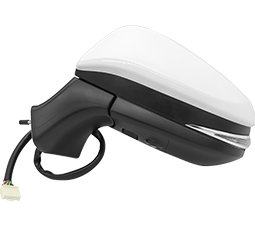2025-03-14
The design of automatic side mirrors plays an important role in modern car manufacturing. Its main purpose is to optimize aerodynamic performance to reduce wind noise and fuel consumption. With the development of the automobile industry, more and more manufacturers are adopting streamlined design, electronic folding function and even digital mirrors to improve fuel economy and driving comfort.
1. Aerodynamic Optimization
Aerodynamic principles are crucial in car design, especially when driving at high speeds, air resistance will directly affect fuel consumption and noise levels. Traditional side mirrors may generate large turbulence when the air flows, increase air resistance (Drag), and thus affect the fuel economy of the car. Modern automatic side mirrors optimize aerodynamic performance in the following ways:
Streamlined design: The side mirrors of modern cars usually adopt a more rounded shape to reduce the formation of air turbulence, allowing air to flow more smoothly through the mirror surface, thereby reducing wind resistance.
Tilt angle optimization: The air flow direction is taken into account during the design to ensure that the airflow can pass smoothly through the edge of the mirror, reduce the turbulent area, and reduce wind noise and air resistance.
Air Channels: Some high-end models have air channels designed in the rearview mirrors to make the air flow along a specific path, reduce the turbulence caused by the airflow hitting the mirror surface, and reduce noise.
2. Wind Noise Reduction
Wind noise is a common problem when the vehicle is driving at high speed, and the rearview mirror is one of the main sources of wind noise. Traditional rearview mirrors are angular and easy to generate vortices when the air flows, which increases the noise in the cockpit and affects the driving experience.
Integrated bracket design: Many modern models of automatic side rearview mirrors use a more compact bracket design to reduce the wind noise caused by air hitting the bracket.
Edge optimization: Use smooth edges or add tiny guide structures to make the airflow more evenly distributed around the mirror surface, thereby reducing noise.
Intelligent electric folding: When driving at high speed, the rearview mirrors of some vehicles can automatically adjust the angle or fold to further reduce wind resistance and wind noise.
3. Fuel Efficiency Improvement
Reducing air resistance is crucial to improving fuel economy, especially when driving at high speeds, where air resistance accounts for a large part of fuel consumption.
Air resistance reduction: By optimizing the shape of the rearview mirror, the airflow is smoother, reducing the resistance that the car needs to overcome, thereby reducing fuel consumption.
Digital Side Mirror: Some high-end electric vehicles (such as Audi e-tron and Honda e) have adopted electronic rearview mirror technology, using small cameras instead of traditional mirrors to significantly reduce air resistance and increase driving range.
4. Auto Folding Feature
The auto folding feature is not only for parking convenience, but also part of the optimized aerodynamic design. When the side mirrors are not needed (such as when parking), the system can automatically fold the mirrors to reduce the protruding part of the car body, thereby reducing wind resistance and energy consumption caused by air turbulence.
The design of the automatic side mirrors conforms to the principles of aerodynamics and plays an important role in reducing wind noise and fuel consumption. Through streamlined design, optimized air guides, electronic folding, and digital rearview mirrors, modern cars can reduce air resistance at high speeds, improve fuel efficiency, and provide a quieter driving experience. In the future, with the application of more intelligent and electronic technologies, the aerodynamic performance of automatic side mirrors will be further optimized, making greater contributions to energy conservation and environmental protection of automobiles.